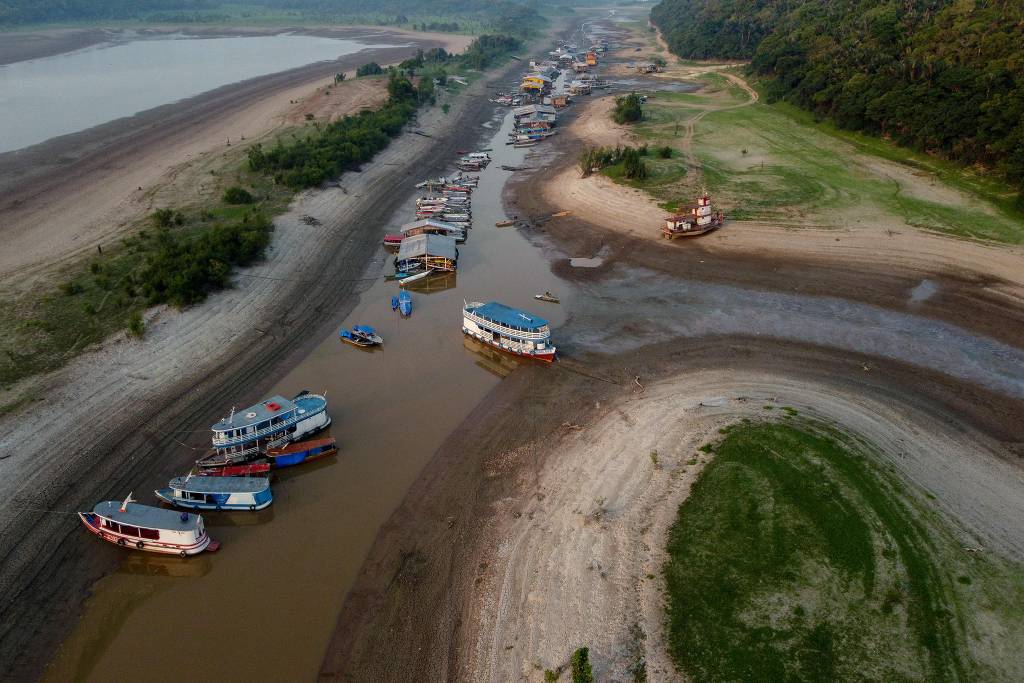Latin America
Related: About this forumDrought in the Amazon Turns Floating Village Lake into Mud
Life has come to a standstill for a floating village, now stranded amidst muddy plains formed by the severe drought gripping the Amazon rainforest region
Oct.9.2023 11:46AM
Bruno Kelly
MANAUS|REUTERS
Life has come to a standstill for a floating village, now stranded amidst muddy plains formed by the severe drought gripping the Amazon rainforest region.
The primary means of transportation, motorboats, lean in the mud, no longer bringing fish, fruits, and vegetables, nor ferrying tourists to witness the meeting of the waters of the Negro and Solimões rivers, where they form the Amazon River.

Aerial view of stranded boats and floating boats at Puraquequara Lake in Manaus, Amazonas State, Brazil, (Photo by Michael Dantas / AFP) - AFP
As Lake Puraquequara dried up, businesses for boat owners and floating shops stuck in the mud also evaporated. Similar to the floods in the southern region of Brazil, the Amazon drought is a result of the El Niño phenomenon, which warms the Pacific Ocean's surface waters, according to experts.
Some rivers cutting through the vast Amazon forest have accumulated volumes of dead fish as the drought worsened. The carcasses of around 120 pink river dolphins were found floating in a tributary of the Amazon River under circumstances experts suspect were caused by severe drought and heat.
More:
https://www1.folha.uol.com.br/internacional/en/scienceandhealth/2023/10/drought-in-the-amazon-turns-floating-village-lake-into-mud.shtml
~ ~ ~
The Life and Death of the ‘Floating City’ of Manaus
To some, this Brazilian neighborhood was a tropical Venice. To others, it was a slum on the water.
BY IGNACIO AMIGO
JUNE 9, 2020
FOR MORE THAN 40 YEARS, Manaus, the largest city in the Brazilian Amazon, had a neighborhood that floated on the river. Located near the Meeting of the Waters, the Floating City was a labyrinthine maze of houses, churches, shops, bars, and restaurants, connected through precarious streets made of wood planks. At its peak, it had around 2,000 bobbing houses built on top of trunks, and a population of more than 11,000 people.
If it hadn’t been destroyed, the Floating City could have become one of the modern icons of the Amazon. Tourists and visitors loved it. It was the subject of features in national and international magazines, where it was often compared to Venice. National Geographic ran a story about it in 1962. And some of the scenes of the Oscar-nominated movie That Man From Rio were shot there. “It was the most vital neighborhood of Manaus,” says Milton Hatoum, a writer from the city, in Portuguese.
However, underneath this layer of fascination was a certain romanticizing of poverty. Most of the residents of the Floating City were low-income families. Sex work and heavy alcohol consumption abounded. And as in most poor districts of Brazil today, there was a lack of basic amenities, such as sanitation and running water.
The story of the Floating City, like the story of the city of Manaus, is closely related to the Rubber Boom. Rubber is made from latex, which is extracted from an Amazonian tree called Hevea brasiliensis. Unlike cotton or sugarcane, rubber trees could not be grown in large plantations at the time, so native trees were the only source of latex. From the end of the 19th century until the first decade of the 20th, virtually all the rubber in the world came from the Amazon forest.
More:
https://www.atlasobscura.com/articles/floating-city-manaus-brazil-history
Before the drought:



